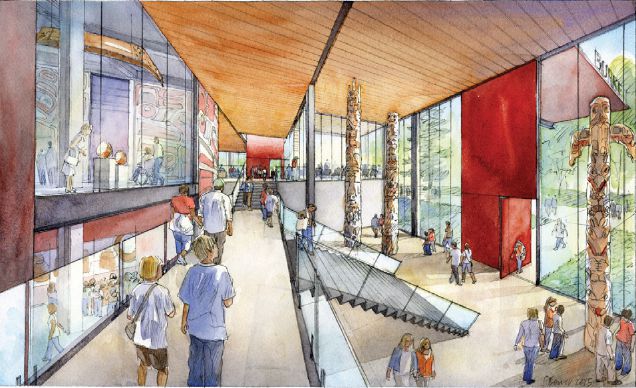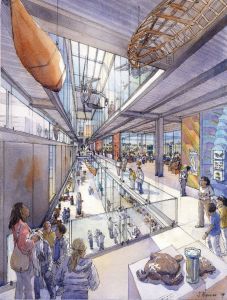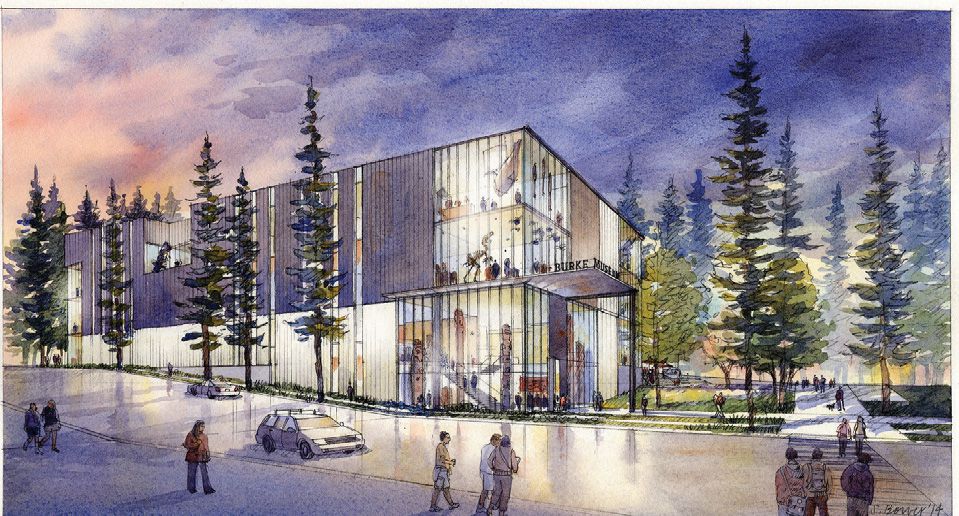
This article originally appeared in the September/October 2015 issue of Museum magazine.
Opening collections, engaging audiences
On a corner near the north entrance of the University of Washington in Seattle, set back from the road and obscured by evergreens, sits the Burke Museum of Natural History and Culture. Hidden behind brick walls hums an active research base with world-class collections of fossils, bones and Native American artifacts (among many, many other things), as well as public exhibits that feature the city’s only mounted dinosaur skeletons. Not that you would know it from the outside—and most Seattle residents don’t.
The Burke hopes to transform into a highly visible (and visited) institution with the construction of a new building that will sit alongside the university thoroughfare near its current location. Glass exterior walls will allow the public to see into the museum. Inside, more glass will give visitors visual access to the museum’s collections and research lab. Groundbreaking is planned for late 2016, dependent upon funding status.
“We are the Washington State [natural and cultural] history museum, so our collection belongs to the public. Technically the citizens of the state own our collections,” explains Eldon Tam, the Burke’s project manager, adding that if Washingtonians “don’t get a sense of objects in the collections,” the Burke can’t fully execute its mission and vision: to inspire people to value their connection with all life and act accordingly. “The short phrase we use is ‘inside out’—exposing the everyday work of the museum, the research staff, the collections,” says Tam. He adds that during the planning process, staff visited other museums but didn’t find a model that seemed to fit the Burke’s identity as a research museum on a university campus. While many museums have a visible lab, often a fossil preparation area, “no one seemed to be doing it nearly to the extent we wanted, to expose everything,” he says. “We’re kind of forging our own path.”
The see-through collection and lab areas take into consideration the needs of the visitor and of the museum’s staff and objects.
“There’s a point of tension there that we need to resolve. How do you balance the light requirements of the collections with the fact that you want the visitors to see the collections?” says Tam, noting that the museum also wanted visitors inside to be able to see outside the museum. “It seemed inappropriate not to get a sense of the outdoors, as a natural history museum.”
The solution came with help from an architectural daylight lab on campus, which modeled how daylight would interact with the new building. The result—in addition to carefully controlled artificial light—is exterior glazing, skylights, and shades with timers and light sensors.
The museum currently exhibits less than 1 percent of its total collection. By turning the museum “inside out,” as Tam says, visitors will have a view of almost all the collection spaces. Not all of the museum’s collection objects, however, will be fully visible. It isn’t feasible to put windows into the bank of huge freezers that make up the genetic resources collection, and there will be pockets of collection spaces hidden from public view to protect, for example, culturally sensitive objects or lab spaces for handling hazardous materials. But the general idea is to arrange small displays of objects near the windows for visitors’ benefit while letting them see into collections areas and extrapolate on the vastness of the Burke’s holdings. “These are working labs,” Tam stresses. “We don’t want them to be show labs.”

In addition, the museum is creating “experience alcoves” to bridge the traditionally public side of the museum with its traditionally hidden side. Four of these roughly 600-square-foot areas will be located adjacent to collections and lab spaces. They’re designed to be flexible, able to host school groups and visitors, with interpretation that can be changed quickly. Glass doors to the adjacent lab space allow visitors to see into working labs; they can be opened and a rolling counter placed in the doorway to allow docents or scientists to interact with visitors, or they can be fully opened to allow visitors into the lab space (of “clean” labs, where dangerous tools or chemicals are not a worry). Visitors won’t be able to enter the paleontology prep lab, for example, but they will be able to enter the paleontology curators’ lab. One of the culture experience alcoves (for ethnology) is adjacent to a workshop where artists can study and work on everything from Native American basket weaving to watercraft. Its 600 square feet of space can expand or shrink as needed to allow work and interpretation to take place in the artists’ workshop. And the archeology department opted to combine their alcove and gallery space into one larger, flexible area.
Programming for the museum’s new incarnation is still in development, but, Tam says, “Access requires more staff in order to be successful.” The museum plans to hire personnel who have a collections background but can still focus primarily on the visitor. “ So basically they’re the interpreter between the research and the visitor,” he says.
Enhancing the museum’s accessibility also requires engaging the community—ensuring that as wide and diverse an audience as possible will come through the doors of the new facility. The Burke’s staff aren’t waiting for groundbreaking to begin these efforts. “Moments of transition are an opportunity to question who you are and who you serve. There’s a greater capacity for change,” explains Brian J. Carter, the Burke’s manager of exhibit experiences. He leapt into action after coming to the Burke just shy of one year ago. Physical plans for the new Burke building were well underway, but Carter had loftier goals: “How can we better engage communities? We listen instead of talking, and we do it again and again and again.”
The Burke has a small, loyal community of visitors dubbed “Burke nerds.” As is true for many museums, the Burke’s visitors are likely to be white and highly educated. In a city that’s nearly 70 percent white, generally highly educated, and with a median household income well above the national average, what does successful community engagement look like? “Who isn’t coming?” is the easy question—the harder questions are “why not?” and “what can we do to change that?” Or, as the Burke phrases it, how can the museum be “a place where everyone will feel welcomed, acknowledged and respected”?
The museum partnered with the university’s business school to conduct market research and hired an audience researcher firm; they’re finishing their second year of participation in the Washington Informal Science Education survey. Perhaps more important than the formal reports are the ongoing conversations, which have expanded to cover the topic of plans for the new building. The museum’s Native American Advisory Board, which meets twice a year, was involved in both the architectural and exhibit planning, and working groups for each topical area (paleontology, archeology, etc.) are helping to shape exhibit planning for the new structure.


The museum also recently wrapped up their Community Ambassador Project, an effort to give the Burke “access to a lot of people who hadn’t been to the Burke and [ask] them about their experiences with museums in general—natural history museums, and the Burke in particular—and how can we support the issues in their lives and the things they’d like to learn about,” explains Tam.
The basic idea was to recruit 12 diverse ambassadors who could, in turn, each recruit 10 community members to participate in listening sessions. The resulting conversations would help the Burke form relationships with new audiences and inform future museum decisions.
Carter assembled an internal working team made up of the museum’s director of external affairs, the project manager, the curator for Pacific and Asian culture, and himself. They met every two weeks to plan everything from logistics to philosophical underpinnings. With the help of a consulting firm and the support of the museum’s executive director, they participated in facilitation training and created an overarching charter that set out the project’s goals, scope, process, and strategy.
Their overarching goal of making a “significant shift in how the institution relates to the community” is broken into short-, medium- and long-term goals: by 2015, a better understanding of the communities they hope to serve; by 2017, the development of exhibits and experiences that “reflect the input of the broader community” and “engender the concept of ‘public as a philosophy.’” By 2020, the Burke hopes that its relationships with the ambassadors will make the museum “an invaluable resource for a much larger and more diverse community.” The project charter also includes principles of engagement to guide everyone involved: engage diverse voices, listen, build trust, share what they learn, demonstrate stewardship and show appreciation.
The 12 ambassadors (who, for the purposes of the pilot project, come from the Seattle metro area) are connected to different local communities and have ties to the Burke ranging from tenuous to deep. The internal working group asked the museum’s staff to reach out through their personal networks to potential ambassadors, seeking to gather as diverse a group as possible. Each ambassador assembled a group of about 10 of their peers, with the goal that the groups would reflect future Burke visitors.
“These aren’t focus groups,” stresses Carter. “A focus group wants specific approval or critiques of a specific product. We’re not going in knowing the answers we want to get.” He reiterates these thoughts while welcoming a small group of women gathered at the Seattle Central Library for a listening session. They are all involved in local nonprofit organizations and have been recruited by one of the Burke’s ambassadors, a program manager for the Seattle Public Library. “I really want to hear your thoughts and perspectives,” Carter tells the group. “How can we convince new audiences that the Burke is theirs?”
Four broad questions are written on a whiteboard: What are your experiences with and perceptions of museums? If you have visited the Burke, what motivated you to do so; if not, why? What’s important to you and your community right now? What role can the Burke play in your life and your community? Carter considers the last question the most important.
Over the course of about 90 minutes, Carter gently steers the otherwise unstructured listening session through those broad questions. The conversation ranges from discussions of the cost of admission and parking to concerns over politics, conservation issues and the rising cost of living. “Why don’t local nonprofits cooperate more? It seems like they don’t talk to each other,” one woman observes. “How is the Burke relevant to me when I can’t afford rent?” another asks. Eventually, the group wishes aloud that the Burke would be a part of things outside its walls, with a priority on coming to people who can’t easily get to the Burke. They wonder if technology is part of the answer.
With the first round of listening sessions completed, Carter’s internal working group and the project’s ambassadors will decide on 10 key findings to bring to the museum. “That’s when the work really starts,” says Carter. “How can we use those 10 key findings as a measuring stick or a guide to develop strategies and tactics that align with the needs of our community and achieve our mission?” The project will continue to work with the original 12 ambassadors who, Carter explains, can provide deep and ongoing access to communities and individuals that the Burke simply can’t reach. Post-listening session questionnaires showed that the ambassadors considered their participation a positive experience, which Carter considers a victory.
“I really appreciated the Burke’s effort in this light,” says Cassie Chinn, deputy executive director of the Wing Luke Museum of the Asian Pacific American Experience in Seattle and one of the Burke’s ambassadors. The Wing (as it’s known for short) has a strong reputation for grounding their work in their community. “[The Burke] stepped out to do something they hadn’t done as robustly in the past…That example of leadership was encouraging,” she says, adding that even museums with established community reputations can always strive to improve: “More than just listening, how do community members become direct decision makers … and what is the accountability back to those community members?” At the Wing, community members are deeply involved from start to finish with every exhibition the museum creates.
To Chinn and Carter, museum access should expand beyond collections objects to the institution’s functions and processes. “Look at your strategic plan and how you go about doing things,” says Chinn. “What are all the ways we could go about engaging community more and integrate them into this process [and] have them take a decision-making role?”
Carter notes that while the new building is an opportunity for the museum to examine its community relationships, the structure won’t catalyze change by itself. “It’s essential for museums in general” to be engaging their communities, he says. “This is where museums need to be going.”
Tam agrees that the Community Ambassador Project is part of an ongoing effort: “The next stage of the Burke isn’t just about a new building. It’s relaunching an entire organization, its posture and how it serves the public,” he says, adding that after the new building opens, continuous feedback will help the Burke “morph and change and adapt to an evolving society.”
“If we relentlessly pursue engagement,” says Carter, “magical things will happen.”
Winifred Kehl is a museum exhibit developer and science writer based in Seattle.







